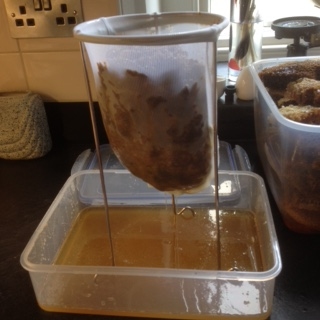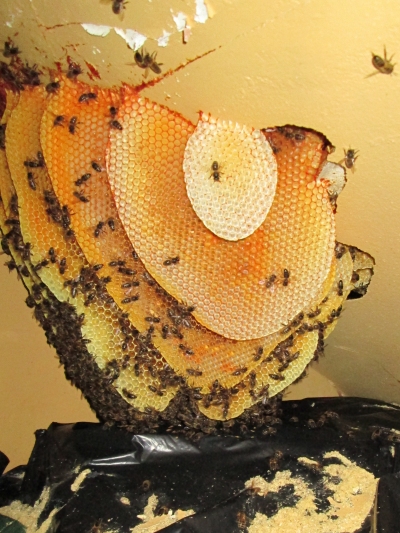
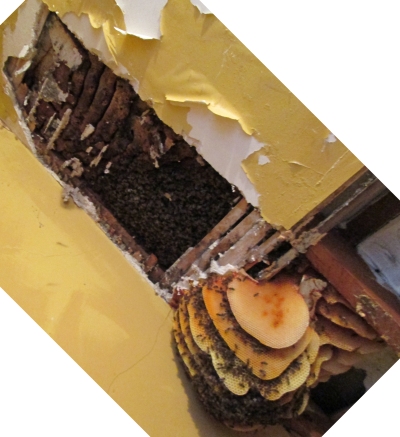
Colony between rafters of a gable end -- October 2016
The bees were entering under the slates near the gable end on an old house, where the lime torching had either fallen away or not been replaced after a roof repair.
The cavity was apparently first occupied in 2010. Bees were entering via an air brick at the top of a disused flue embedded in the gable end. When this was covered with mesh, the bees simply transferred their entry to the gaps between slates. Eventually this first colony was destroyed by Rentokil. However, a swarm entered in 2014. As part of the ceiling was soft fibreboard, the bees were able to chew it away to expand their nest downwards into the box room below. This was not possible higher up the nest because it was contained by a lath and plaster ceiling. The colony had clearly become very intrusive for the house occupants, especially as many bees were finding their way into rooms lower down the building via various passages in this old building. The decision was therefore taken to remove the nest completely.
Below left: lower part of nest
showing fibreboard chewed away.
Below right: upper part of nest exposed after lath and
plaster removed between adjacent rafters.


Below left: upper part of nest
showing old, dark comb, probably from the previous colony.
Below right: an exposed brood comb in the lower part of the
nest.
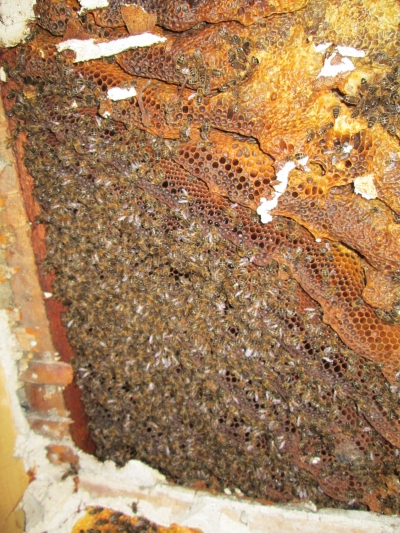
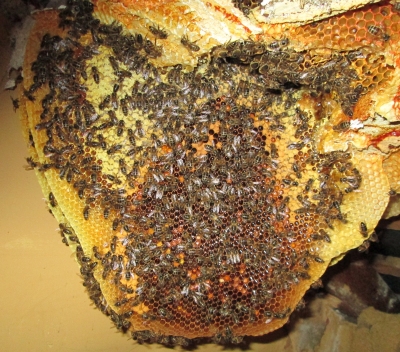
While using a bee vacuum fitted with a Warré hive box, the combs were cut out and sorted according to brood or salvageable honey for human or bee consumption.
Below left and right: combs removed showing slates and slate battens.
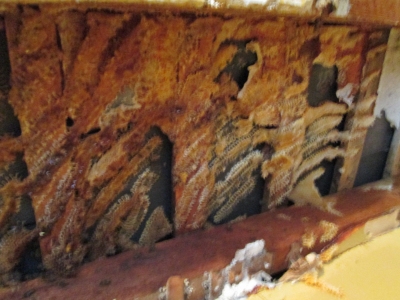
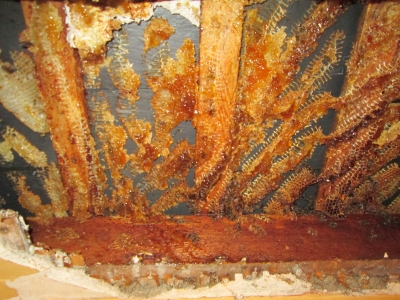
Below: adjacent space between two rafters showing that the nest had not expanded into it.
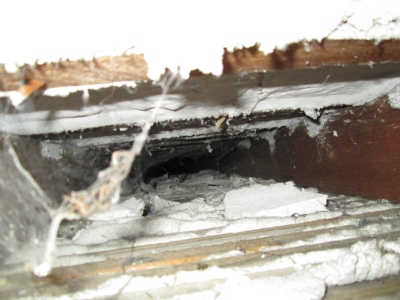
At the end of vacuming, some bees still in the air grouped on the vents of the bee vac, suggesting that they were attracted to the queen. The vac was left outdoors overnight. The bees were still on the vents by morning.
The bee vac's hive box with the bees was placed over newspaper on a hive that was apparently queenless. The paper had many small perforations to allow scents of the two colonies to mingle before the bees made contact with each other by chewing through the newspaper. This precaution avoids fighting and many deaths. Residual bees in the base of the vac were shaken on the ground in front of the hive. They took to the air and settled at the junction between the two boxes with the newspaper (red line in photo below). This was a further indication that the queen was in the vac box.
There were a hundred or so casualties from the vacuuming process (yellow line in photo below).
Below left: bee vac box placed
over newspaper on a Warré hive.
Below right: detail of casualties from bee vac process.
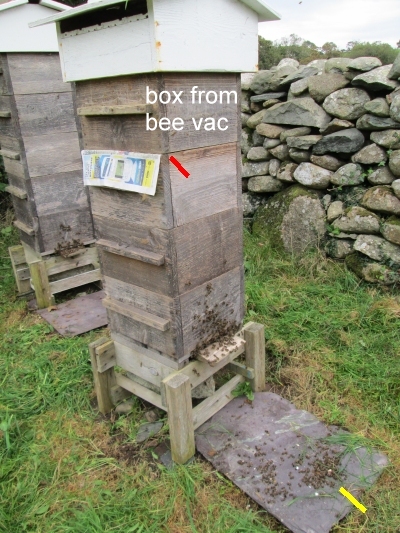
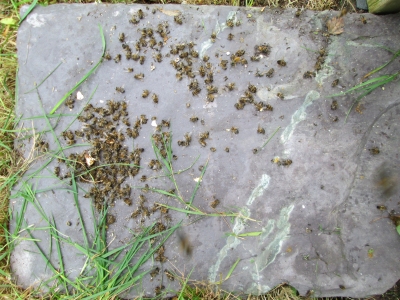
On returning to the apiary on the following day in good weather with hazy sunshine there was intense activity at the hive entrance and many bees orientating in the vicinity of the hive. Pollen was pouring in often with three or more pollen carriers on the alighting board at any one time. Intense pollen influx is a further sign that it is a 'queen right' colony. The board over the top hive box, the one from the bee vac, was lifted. It had a cluster of bees on it and a comb primordium. The newspaper has been extensively chewed away.
Below left: view into top hive
box, i.e.the one from the bee vac.
Below right: top hive box removed showing chewed newspaper.
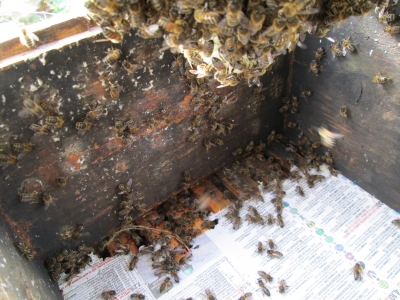
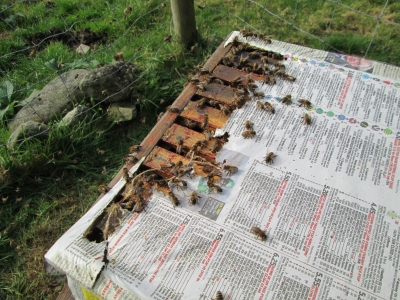
Below:
Hive entrance at about noon showing three pollen carrier bees, two bees scenting with
their Nasanov glands at the base of the abdomen exposed (white lines) and one wasp about
to try its luck at robbing the hive. The scenting helps guide bees 'home', especially
after a disturbance to the colony, such as the action of removing the top box.
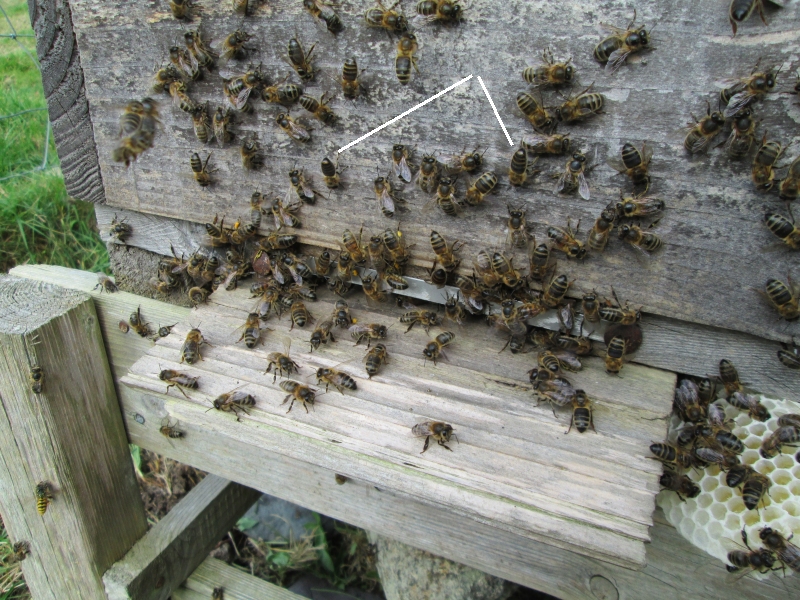
The real test of of this queen is if she and the workers can raise enough 'winter bees' to see the colony through the next five months until the first nectar flows of spring. The hive will be 'hefted' to gauge the weight of the honey stores and a supplementary feed given using the honey salvaged from the original colony in the roof. In this locality, 9 kg honey generally suffices to fuel a colony through the winter.
To prevent a future infestation, the householder was advised as far as possible to remove any residual comb adhering to the slates, battens and rafters and, before replacing the ceiling, to fill the space between the rafters with roof insulation e.g. rockwool.
The householder was able to recover honey from about 28 pounds of clean comb cut out from the newest part of the nest.
Below: extraction of honey from this roof colony by the crush and strain method.
